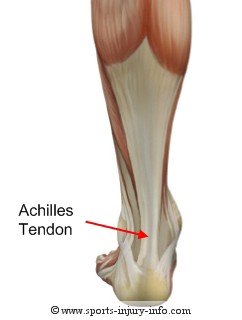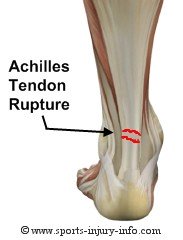Achilles Tendon Rupture
Achilles tendon rupture is not an extremely common sports injury. Not nearly as often seen as achilles tendonitis, it is significantly worse. The most common population that suffers from achilles rupture is over 30 males.

This injury is often preceded by achilles tendonitis,
which may
weaken the tendon and eventually result in the rupture.
What
does an achilles tendon rupture mean for your sports participation? Read
on to find out.
The Achilles Tendon
The achilles tendon is the insertion of the gastroc and soleus muscles into
the calcaneus of the foot.
It
provides the connection between the lower leg and the ankle, and allows
for you to be able to point your toes. It can also be a very
common site for tendonitis, and for tendon rupture.
How It Occurs
Achilles tendon rupture can occur with many different types of sports activities. The most common way to tear it is with some type of explosive activity involving the foot. For example, changing direction while playing tennis, anding forcefully on one leg, or breaking into a sprint.
Signs and Symptoms
All
of the patients I have seen with this injury tell me that it felt like
someone kicked them in the back of the leg. They had immediate pain,
swelling, and significant strength loss. They were unable to walk
normally, and could not stand up on their toes.
You
may also have severe bruising along the back of the calf, and may be
able to feel a lump, or space along the tendon itself.
Treatment

The initial treatment for achilles tendon
rupture is to follow the R.I.C.E. principles.
It is also extremely important that you see your physician as soon as
possible. If you have any of the symptoms above, it is imperative that
you seek medical attention. The success of your recovery depends upon
it.
Most achilles tendon ruptures must be treated
surgically.
There is so much natural tension on the achilles that there is no way
for the two ends to approximate close enough to heal. Often, the muscle
end of the tendon will retract up into the calf.
The
success
of achilles tendon repair is closely associated with how quickly
surgery is performed. The longer the time from injury, the more likely
the tendon will retract farther, making it harder for your surgeon to
repair the tendon successfully.
Prevention
Remember...
The best treatment is prevention. If you can avoid this injury, you will save yourself months of rehabilitation and time away from your activities.
Regular
calf stretching is vital to prevent achilles tendon rupture. The less
stress on the achilles, the better. Make stretching a part of your
daily routine, and definitely before and after sports. Compare 5
minutes of stretching everyday to 6 weeks on crutches, and 3 months of
rehab. It is well worth it.
The other key to
prevention is to
pay attention to achilles tendon pain. Many times a full blown rupture
is preceded by tendonitis and other problems. This is what weakens the
tendon enough to cause the rupture. So, if you have achilles tendon
pain, seek treatment and get it taken care of. It will save you a lot
of frustration and pain later.
If you are currently suffering from achilles tendonitis, plantar faciitis, ankle, or foot pain, you could benefit from a comprehensive foot and ankle strengthening program. Foot Pain Solutions is exactly what you need to help eliminate your foot, ankle, and low leg pain. Great for prevention too, Foot Pain Solutions can guide you to finally getting rid of your chronic foot and ankle pain.
Read more about Foot Pain Solutions
Summary
A rupture of the achilles tendon is a serious ankle injury. It needs to be evaulated by your physician as soon as possible. Generally treated surgically, there is a good prognosis for return to sports after rehabilitation. Make sure you stretch before activity to work to prevent this injury. And if you have achilles tendon pain, don't ignore it. Get it taken care of. It could help keep you off the sidelines.
Didn't find what you were looking for? Search SII for more information...Running Pain Solutions
Written for Runners by a runner, you'll learn a holistic approach to improving mobility, restoring normal movement and muscle activation patterns, and restoring the body and mind connection.
This Kindle Book contains a step by step program to keep you running pain free. Included are detailed instructions and illustrations for exercises to improve mobility, balance, neuromuscular control, strength and endurance. Only $7.49!
Get Your Copy Today!









